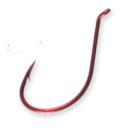 Out of necessity I went “Old School” on all my flies tied this season. My hook stash was light on all the Tiemco, Gamakatsu, Daiichi, round-wire trout hooks, so I dug deeper into the morass to find Mustad 94840 and 3906B’s, the old standards.
Out of necessity I went “Old School” on all my flies tied this season. My hook stash was light on all the Tiemco, Gamakatsu, Daiichi, round-wire trout hooks, so I dug deeper into the morass to find Mustad 94840 and 3906B’s, the old standards.
Having fished both Japanese chemically sharpened and Mustad forged hooks for over a decade each, I hadn’t thought to compare the two until I found myself attempting to restock my larder.
Per normal, the Japanese hooks are sold in the $16.00 per hundred range, the old Mustad’s are still available and are half the price. I like the Japanese hooks, but are they twice as good as price suggests?
In a non-scientific test, here are my observations (season to date):
Japanese hooks are a dab more malleable steel, their barbs pinch down without breaking off the entire hook point, and they deform more easily than their forged counterparts. While bending the wire back into the original shape seems no issue, I suppose there is a bit of weakness introduced.
Mustad forged hooks (94840) are a rigid brittle steel, pinching a barb down with pliers is always a risk, as some percentage always seems to lose both barb and point, rendering the fly a write-off. Deformation of the hook due to a snag on an unyielding surface is nonexistent. Because of this, some loss occurs when the entire point/barb assembly is snapped off when the fly comes free.
Japanese hooks on the whole seem better made. Mustad hooks always will have 3-4 hooks per box that have improperly closed eyes, or a gap large enough that must be sealed by the tyer with thread.
Both vendors have annealed hooks; the finish is not quite dry and two or more hooks stick together, most can be separated so the issue is trivial.
The Japanese hooks have a wider variety of hooks, but that may be artificial, as the vendors may stock more of their hooks than the cheaper selling Mustad flavor. It does appear as if they are available in more diverse wire types, curvatures, and colors.
The round wire Mustad nymph hooks have the same qualities as their Japanese counterparts; softer, more malleable wire, little issue with barb pinching. This is consistent with the forging process, as a swaged wire should resist better than a round wire. I assume we can use the house rafter analogy, as round rafters were abandoned a hundred years ago in favor of the current “forged” or rectangular construction.
On the whole, it would appear that current Japanese offerings are slightly better made, and slightly more diverse, but twice as expensive. I am not convinced that they are twice as good.
Mustad has their new line of Signature hooks which I have not yet tested. These are roughly the same cost as the Japanese flavor, and they might be worthy of consideration. I will report back on them as soon as they arrive.
In summary, fish both with confidence. To spare yourself destroying your last #18 Black Ant, you may want to pinch the barb before the fly is tied. You will be inconsolable if the fish are rising in great numbers, and that is all they are stupid for…
Technorati Tags: Mustad, Tiemco, Gamakatsu, Daiichi, fish hooks, fly tying, hook comparison
